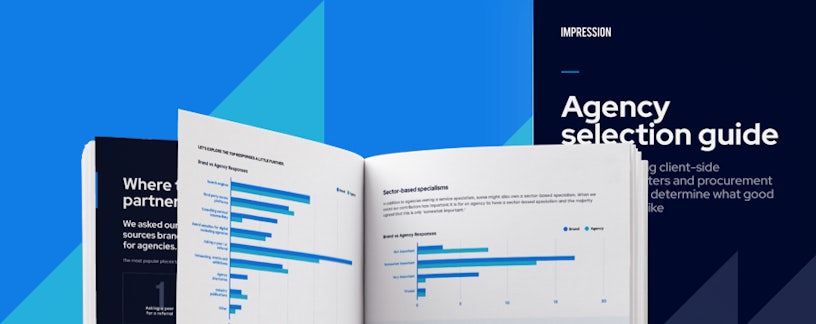SEO and PPC are often the bread and butter of many marketing strategies. This is because we as consumers love to use search engines.
Search advertising accounts for around 42% of digital marketing revenue globally each year – and Google alone processes in excess of 8.5 billion searches per day. Whether we go somewhere, research a product/service or make a purchase, our typical online journey will often feature a search engine, and sometimes more than once.
But too often brands handle their SEO and PPC strategies in silo. The famous ‘war of the SERPs’ is often fueled by the fact the two channels are managed by different teams or agencies, and often get pitched against one another.
While they do have several fundamental differences, finding a way to integrate your activities and to look at search more holistically can create results that wouldn’t be possible when working in silos. While this may sound simple, there are always challenges, for example, having a clear, mutual understanding of the role of each channel and the pros and cons that come with that.
There’s plenty to unpack here. Use the links below to navigate to a specific section:
- Defining SEO and PPC
- What is search engine optimisation (SEO)?
- What is PPC?
- What are the differences between SEO and PPC?
- SEO and PPC focus on different features of the SERP landscape
- PPC involves paid ads; SEO requires an investment in time
- Metrics and KPIs for SEO and PPC
- Weighing up the pros and cons
- Benefits of SEO
- Challenges associated with SEO
- Benefits of PPC
- Challenges associated with PPC
- Should I invest in SEO or PPC?
- SEO and PPC integration strategies
- Maximising your visibility in the SERPs
- Data sharing to highlight opportunities and keyword gaps
- Using Google Ads search term reports to learn and inform
- Identifying content gaps and long-tail keywords
- Holistic search behaviour analysis
- Landing page experience and Google Ads Quality Scores
- Cross-channel promotion
- Analysing assisted conversions and channel interaction
- Finding a cross-channel agency partner
- Next steps
Ready to discover how SEO and PPC could work for your business? Speak to our team today.
Defining SEO and PPC
What is search engine optimisation (SEO)?
SEO is the process of improving your website to help it rank higher in the search results for queries made on search engines like Google and Bing.
But today, search is becoming more fragmented as users are using social platforms (e.g. YouTube, TikTok) and even retailers (e.g. Amazon) to search. As a result, this has introduced a new dimension to the practice of SEO.
Holistic SEO strategies focus on three main pillars:
- Technical: Optimising the technical foundations of your website to offer a better user experience whilst enabling search engines to crawl, index, and rank your pages.
- Content: Work that focuses on written and multimedia content on your landing pages, optimising them for users and search engines.
Off-page: Activities done off-site to build backlinks towards your domain and improve its authority – each link to your site is viewed as a ‘vote of confidence’ by search engines, passing on link equity that helps your pages to rank higher.
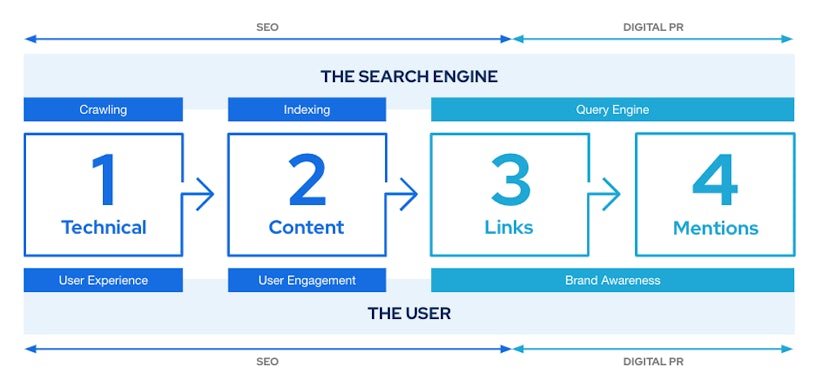
What is PPC?
Pay-per-click (PPC) is a form of digital marketing where advertisers pay each time a user clicks on one of their ads by bidding on keywords for a chance to show in their search results.
The most common form of pay-per-click is through search engines such as Google and Bing, where users bid to appear at the top of the SERPs for relevant keywords. The ads offer great flexibility as you can make real-time changes to your targeting audience, bid strategy, budget and ad copy.
Businesses use PPC ads to ensure their products and services are highly visible at the exact moment a user is searching for exactly what they offer.
What are the differences between SEO and PPC?
In summary, SEO is a set of practices that you follow to organically improve your visibility on search engine result pages and drive traffic to your site. PPC (pay-per-click) is a form of paid advertising where sites pay each time their paid search, social or display ad is clicked.
However, the true answer to this question is more complex as there are many other key differences, such as:
- SEO and PPC focus on different features of the SERP landscape
- PPC involves paid ads; SEO requires an investment in time
- Channel performance is measured with different KPIs
- PPC can provide quick results while SEO focuses on the long-term
- SEO targets users purely on keywords, while PPC can layer in geo and demographic targeting
SEO and PPC focus on different features of the SERP landscape
Gone are the days when the SERPs only included blue links – today the modern search landscape is complex and diverse. It’s filled with different types of SERP features, many of which are up for grabs and provide their own opportunities.
Generally, each feature fits into one of the following categories:
- Knowledge graph features: Appears in a panel or box on the SERP, often on the right-hand side.
- Rich snippets: Adds extra visuals to a result, like stars in product reviews or photos in news results.
- Paid results: You can buy these by bidding on relevant keywords. Paid results will include a label at the top to specify that the result is an ad.
- Universal results: Special results that appear alongside organic ones, such as Images, Videos, Maps, News, and Shopping.
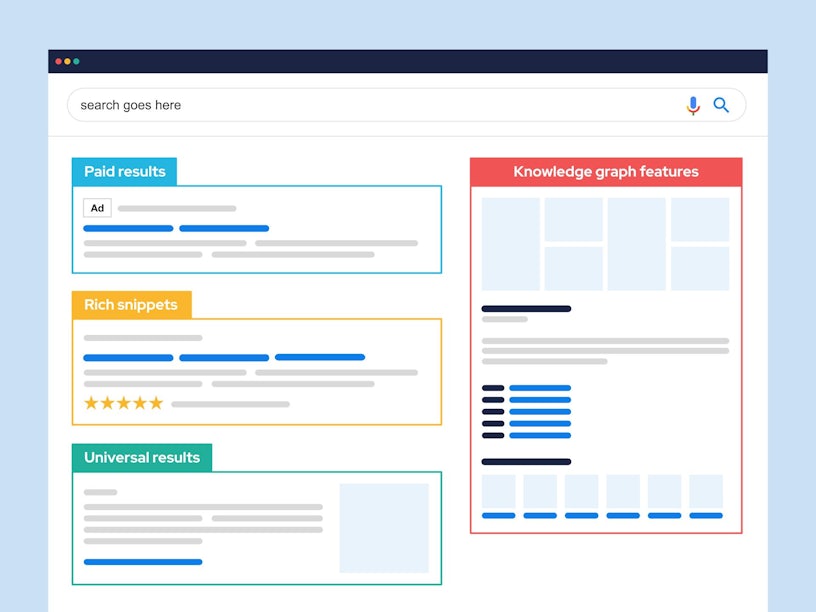
With the exception of paid results and a few outliers, the majority of the features you see here can be influenced by SEO in some shape or form. Well-informed digital marketers will understand the difference between organic features and those that sit within the umbrella of PPC. Beyond this, capturing these results for your site is a matter of understanding their individual nuances (and this is covered in greater depth in our guide to SERP features).
PPC involves paid ads; SEO requires an investment in time
One of the most obvious differences between PPC and SEO is the different types of investments required to be successful.
While both require time to set up, monitor and optimise, PPC delivers quicker results as you can effectively have an ad campaign researched, set up, running and driving traffic within hours if you truly want to. (That said, we’d always recommend a more careful and considered approach to running PPC campaigns.)
SEO typically takes longer to deliver meaningful results. The time required to achieve growth depends to a great extent on the position and condition of your website, Without the right technical foundations to begin with, an SEO campaign can take a good while to get off the ground even if you have significant resource to put into content.
The old adage ‘content is king’ still rings true today – and content is where the majority of time and effort is invested for many SEO strategies. Within this area of SEO, time is typically split between creating new landing pages and optimising existing ones (improving visibility for existing rankings and acting on new keyword opportunities as they arise).
Beyond this, you will also need to invest time and effort into link building, which will require you to explore creative ways to secure links naturally, from relevant, authoritative sources. This largely means creating newsworthy content that can be shared with journalists and publishers on their sites, which again all takes time.
And all of this doesn’t take into account ongoing technical maintenance. A sizable portion of any SEO strategy should be dedicated to crawling your website routinely and addressing any technical issues (which often need a web developer’s time and support to resolve).
Ultimately, the key difference comes down to investing more time vs money. PPC will cost you more in the immediate term, but you’re paying the price to quickly access and reach relevant audiences. Investing in SEO is a long-term move: it won’t yield results instantly but the ROI of SEO compounds over time.
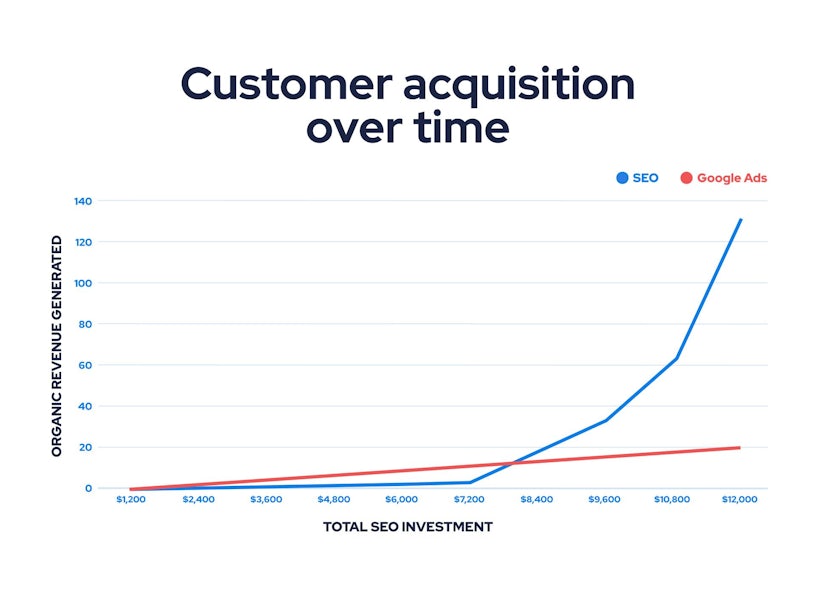
Metrics and KPIs for SEO and PPC
The metrics used to assess opportunities and analyse performance in SEO and PPC advertising differ due to the distinct nature of these two digital marketing channels. While both are important and there is some overlap, they will often play different roles in the marketing mix and therefore will require different KPIs to measure their performance accurately.
In SEO, metrics focus on organic search visibility, website traffic, and user engagement.
Key metrics include:
- Organic search rankings for target keywords (often referred to as visibility)
- Organic traffic volume (sessions / clicks)
- Click-through rates (CTR) from search engine results pages (SERPs)
- Organic conversion rate
- Organic conversions.
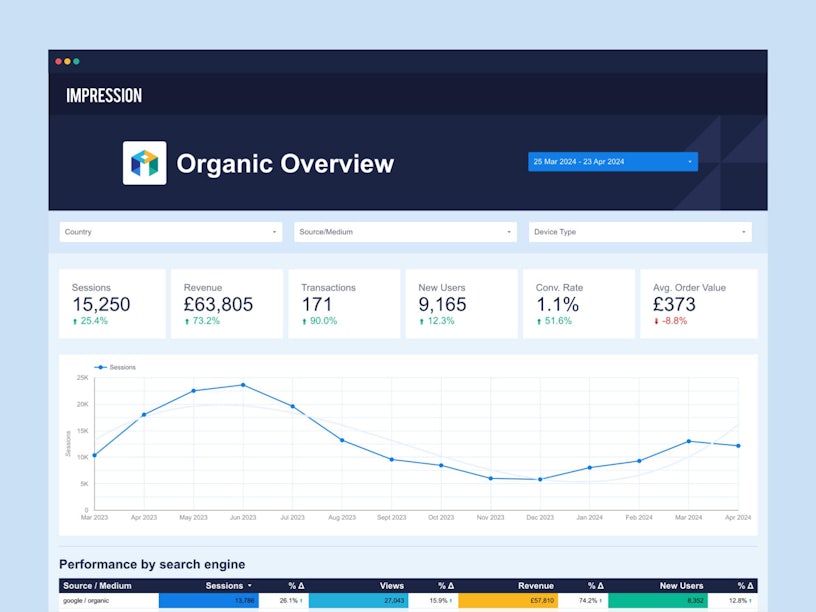
These metrics should then be underpinned by quality and engagement metrics such as bounce rate, time on page, and pages per session. Taken together, this data provides useful insights into the effectiveness of SEO efforts in driving organic search traffic to the website, as well as user behaviour and satisfaction with the website’s content and user experience (factors which are increasingly vital to organic rankings).
On the other hand, PPC metrics revolve around paid advertising performance and return on investment (ROI).
Key metrics in PPC include:
- Click-through rate (CTR)
- Cost per click (CPC)
- Conversions
- Conversion rate
- Cost per acquisition (CPA)
- Return on ad spend (ROAS)
- Impression share (IS).
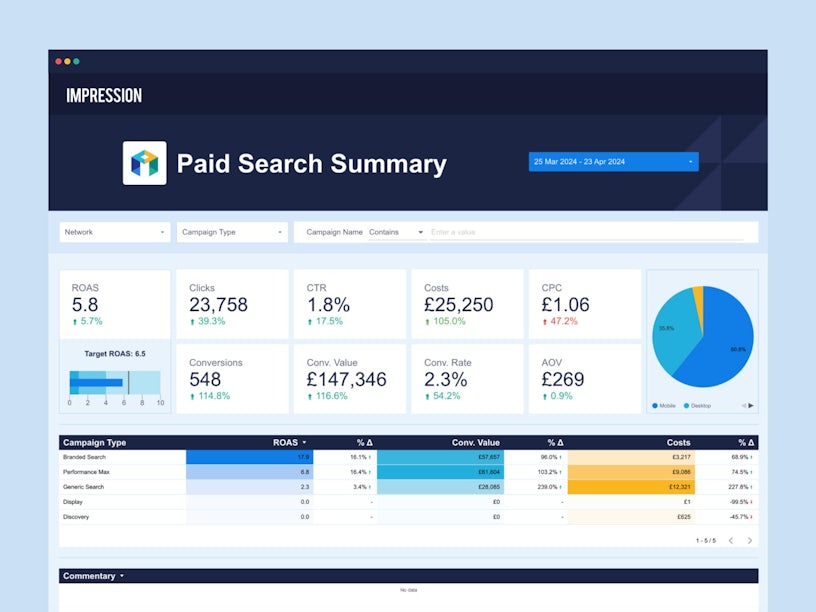
These KPIs focus on the effectiveness of paid ads in generating clicks, conversions, and revenue, as well as the efficiency of ad spend in achieving marketing objectives.
Additionally, PPC platforms provide detailed targeting and audience segmentation metrics, such as demographics, location, device type, and interests, which allow advertisers to assess the relevance and effectiveness of their ad targeting strategies.
Weighing up the pros and cons
Both channels play an important role, offering different benefits and challenges – but how do you know which is most suitable for your situation?
To answer this question, you need to understand the key benefits and challenges for each channel so you can see which best suits your business needs and objectives.
Benefits of SEO
Search engines receive billions of searches every day – and many of those are conducted by potential buyers – so there’s no doubt that SEO provides great opportunities and benefits for your business. But let’s take a look at some of the key benefits of SEO:
- You can attain visibility for popular search queries organically, effectively driving traffic for ‘free’.
- Having visibility in the SERPs can create trust, credibility, brand awareness and exposure.
- It’s cost-effective – while you initially spend time and effort on your website and content production, you can continue to reap the rewards with the right maintenance.
- It connects you with customers throughout their buyer’s journey as you can optimise and appear for different types of search queries (from top-of-funnel informational keywords to transactional terms that users search right before purchasing).
- SEO is a scalable customer acquisition channel, with the impact of optimisation often snowballing over time.
- Results are quantifiable and easy to measure.
Challenges associated with SEO
However, as with any marketing channel, SEO presents certain challenges for digital marketers:
- Staying up-to-date and in line with algorithm changes – as Google continues to experiment with changes to the way their search engines work, securing top rankings can often feel like hitting a moving target.
- Having the resource to create quality content at scale, while considering the different formats and snippets you could be securing in the SERPs.
- The rise of zero-click searches: Google’s Search Generative Experience (SGE) is changing the way users interact with search results. With SGE users can engage in a conversation with AI without having to click through to a landing page to access the relevant information to get the answers they need.
- Getting and maintaining buy-in from senior stakeholders when growth is slow to materialise.
- Keyword and content cannibalisation (where pages compete to rank for the same keywords, often resulting in reduced performance). This is especially challenging on larger ecommerce websites.
Benefits of PPC
PPC advertising offers a multitude of benefits for businesses looking to boost their online presence and drive targeted traffic to their websites.
Arguably the greatest advantage is that PPC provides immediate visibility, allowing businesses to appear at the top of search engine results pages (SERPs) for relevant keywords. This instant exposure can lead to increased brand awareness and website traffic.
Additionally, PPC offers precise targeting options, enabling advertisers to reach their desired audience based on factors such as demographics, location, interests, and even device types.
PPC campaigns are also highly measurable, providing detailed insights into the performance of ads in real time. This level of data allows advertisers to continuously optimise their campaigns for better results, such as improving click-through rates, lowering cost-per-click, and ultimately maximising return on investment (ROI).
But as one of the most powerful advertising tools, there are many more benefits to using PPC within your marketing mix. Some additional benefits include:
- The ability to flex budget – advertisers have control over how much they are willing to spend on each click or conversion, making it suitable for businesses of all sizes and budgets.
- Unlike SEO, algorithm changes have little impact (although there are still industry developments to factor in, such as the requirement to implement Google Consent Mode).
- It’s easy to conduct tests to optimise push and maintain control of your spending and return.
- With new formats such as Demand Generation, advertisers can now advertise across different Google platforms with one campaign.
- PPC advertising provides a wealth of data that can influence other channel strategies such as SEO or content marketing – for example, it can be used to test the effectiveness of ad messaging and provide keyword-level conversion data.
Challenges associated with PPC
While PPC advertising presents numerous benefits, it also comes with its fair share of challenges.
One significant challenge can be the cost. Increasing competition within the digital advertising space is resulting in rising costs per click (CPC). As more businesses invest in PPC, especially for highly competitive keywords, the bidding process becomes more intense, driving up the cost to maintain top ad positions. This can strain the budgets of advertisers, particularly smaller businesses with limited resources, and necessitates strategic budget allocation and keyword selection to achieve desired results within budget constraints.
Another challenge is the complexity of PPC platforms and algorithms. Major platforms like Google Ads and Microsoft Advertising continuously update their algorithms and introduce new features, requiring advertisers to stay abreast of changes and adapt their strategies accordingly.
Additionally, mastering the intricacies of campaign setup, keyword targeting, ad copy optimisation, and bid management can be daunting for newcomers to PPC advertising. Without a solid understanding of these elements, advertisers may struggle to achieve optimal results and may even inadvertently waste budget on ineffective campaigns. Therefore, ongoing education and staying informed about industry best practices are essential to navigate the complexities of PPC advertising effectively.
A few other common challenges with PPC advertising include:
- Sales attribution – with the removal of cookies and ongoing iOS updates, it has become even harder to accurately attribute where your sales are coming from and how to then make the correct decisions on how to scale your best-performing ads and turn off the worst performers.
- Ad fatigue – when your target audience becomes bored or disinterested in your ads, we call this ad fatigue. This can happen if you continue to use the same advert for a long period of time. and/or your creatives are simply not engaging enough. As a result, you’ll see a decline in CTR and a drop in your ROI.
Should I invest in SEO or PPC?
If you need quick results and have a reasonable budget you should use PPC as a priority. But as a long-term strategy, investing in SEO will help to drive substantial ROI in the future. Ideally, it’s advisable to use both channels simultaneously.
This is because combining PPC advertising with SEO can yield powerful results that amplify the effectiveness of each strategy. By leveraging their key difference of immediate vs long-term results will improve your marketing efficiency while allowing you to have a strong presence in the SERPs across the full customer journey.
But unfortunately, SEO and PPC are often handled in silos, treated as competitor services or, even worse, cannibals of each other’s success. For this reason, many will choose to stick to one path, working away to achieve success in the channel they feel works best for them. Further to this, dedicated SEO and PPC agencies offer these services exclusively, eschewing the other in the process and further fueling the longstanding war of the SERPs between organic and paid.
It doesn’t have to – and shouldn’t, in my opinion – be this way. Integrating your SEO and PPC activities together successfully can create results you couldn’t achieve without them in concert, and the data you can gather from this marriage can be a powerful tool in its own right.
SEO and PPC integration strategies
The first thing to understand is why integration of these channels is beneficial, and whether it could work for your business. There are a couple of points to raise here and it’s important to stress that all of these benefits are the product of a well-executed strategy!
Maximising your visibility in the SERPs
One key advantage of using PPC and SEO together is the ability to cover more ground within search engine results.
You can be an SEO guru and put your website at the top of organic results for that key search term you’ve targeted, but if a PPC wizard decides to step in, you’re going to have to take a step off the podium and settle for second, or third… or fourth.
Conversely, a top-paid ad placement is still just that – an advert. Users have gotten accustomed to how Google and Bing deliver ads within their search engines and some users will simply skip right by to look at those trusty organic results. No matter what you do, you’re destined to lose clicks to wary internet lurkers.
But what if we combine powers? If you can capture the top organic placements and have a prominent presence in the paid space too? That’s when you begin to really maximise your visibility.
Some would argue that there is cannibalisation here: you’re either wasting money on a click that could have been organic or you’re wasting time optimising for the queries your PPC team owns.
It’s hard to know what the perfect balance is, but the most important part is to target the right queries with both channels. If there’s no paid competition and you occupy the top organic position, there’s little reason to spend your budget stealing clicks away from your organic result that will gather the majority anyway for free, unless you really want that SERP real estate.
At Impression, we’ve seen excellent results for our clients by monitoring impression share on PPC keywords.
Impression share – the percentage of impressions that your ads receive compared to the total number of impressions that your ads could get.
A high impression share indicates that there’s little competition from other advertisers – and if we’re already ranking in position 1 organically, we may consider pulling back on ad spend for that keyword and allowing our organic listing to take the clicks.
Data sharing to highlight opportunities and keyword gaps
As marketers, we love data. And the more we can get of it to create a complete picture, the better.
So, one of the great benefits of an integrated PPC and SEO strategy is the way they complement each other in terms of data and insights. PPC campaigns provide valuable data on keyword performance, ad copy effectiveness, and audience behaviour, which can inform SEO strategies and vice versa.
For example, insights gained from PPC campaigns can help identify high-converting keywords that can then be optimised for organic search through SEO efforts.
If you are able to use third-party tools to access search demand data, you can marry this with the data provided by Search Console and your PPC account to create a holistic dataset that will be filled with useful insights on search behaviours and performance.
Some popular use cases of using PPC and SEO data to improve your search performance include:
Using Google Ads search term reports to learn and inform
Reviewing the exact search queries used by users who clicked on your PPC ads, along with a number of additional metrics, such as the campaign and ad group triggered, is valuable for SEO as you can use it to uncover a number of things that can help to inform your efforts.
Identifying content gaps and long-tail keywords
You can assess gaps in your existing content and discover valuable long-tail keyword opportunities by reviewing the search terms themselves, looking for any that you’ve received multiple impressions for, or a cluster of semantically similar phrases you can speak about.
Holistic search behaviour analysis
You can use the data and reports provided either in-platform or through third-party tools to analyse user search behaviour, giving you a better understanding of how they’re actually searching within your niche.
Landing page experience and Google Ads Quality Scores
To maximise the performance of any traffic-driving channel, you should also ensure you’re creating a landing page experience that meets or even exceeds the user’s expectations and is an overall positive experience.
Besides helping to improve the on-site conversion rate, improving the landing page experience will also provide huge benefits to other aspects of your PPC and SEO performance. For example, landing page experience is a key factor that contributes to the Google Ad Quality score, so the better the experience, the better your score which means you are likely to pay less to be visible.
Both Google Ads data and data from third-party SEO tools largely end at the click (outside of conversion reporting), meaning it doesn’t track any on-page metrics. It’s far more effective to utilise analytics data to view individual page performance through the analysis of behaviour metrics, user journeys, and engagement. But when used together, you can easily identify the priority pages to review (those with the highest visits) and then turn to digital experience support to boost your engagement metrics.
At Impression, our teams support each other across SEO, paid media, and digital experience to build highly engaging landing pages that satisfy users’ intent – resulting in cheaper CPCs, more conversions, and better visibility across the board.
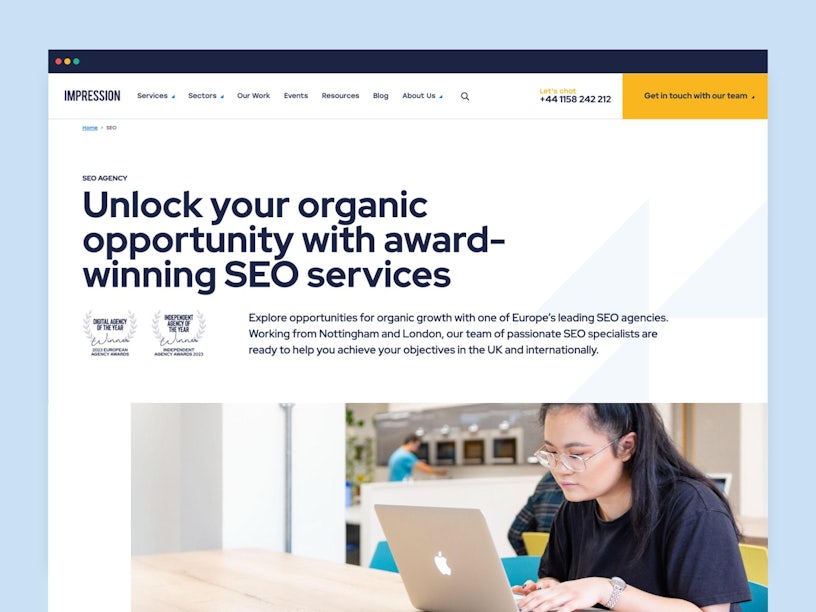
Cross-channel promotion
PPC can be a quick way to drive traffic, and investing in campaigns that help amplify high-performing content can be a great way to expand your reach within a relevant audience pool.
For example, let’s say your business is in the automotive industry and you have a high-converting guide about switching to an electric car.
You may currently see great SEO results and plenty of organic traffic, but imagine what you could do if you expanded your reach and put your guide in front of more in-market users who are potentially on other channels or using other search terms.
This is where remarketing comes in, allowing you to serve ads to users who have previously interacted with your site. You already know that your target audience is interested, so it’s an effective and efficient way to increase lead or conversion volumes for either a specific period of time or as an ongoing activity if it continues to perform well.
Analysing assisted conversions and channel interaction
Assisted conversions are one of the most underappreciated metrics within Analytics, despite being a key aspect of understanding your real conversion funnel.
It’s too easy to see a low number of conversions – or a poor cost/conversion ratio – from a given channel and decide the time spent wasn’t worth it, leading to a reduction in resources – social, referral and email channels often suffer from this, in particular.
An assisted conversion is any channel that a user engages with prior to the end conversion, such as a shopper who found your product through organic search, went away to compare prices, and then came back directly to your site to purchase. In that instance, the conversion would be granted to direct, whilst organic would get an assisted conversion. This data can be found in Analytics under Conversions > Assisted Conversions.

We can see that the above data better illustrates the relationship between different channels and how they typically convert. Note the ratio of assisted conversions to conversions for social networks – it’s 7.25 times more likely to be part of a conversion funnel, but not the key driver. Does that sound valuable to your business? Would conversions have been lost if social had not been a step in the conversion process? These questions can help you to understand how channels are working together, and this works incredibly well for a combined marketing campaign for SEO and PPC.
We can further analyse the relationship of channels by analysing the conversion paths users have taken to convert. Conversion paths provide much-needed context to the previous data and can help you to understand your users better in the process. I’ve used the same dataset as above to provide cohesion in our analysis.
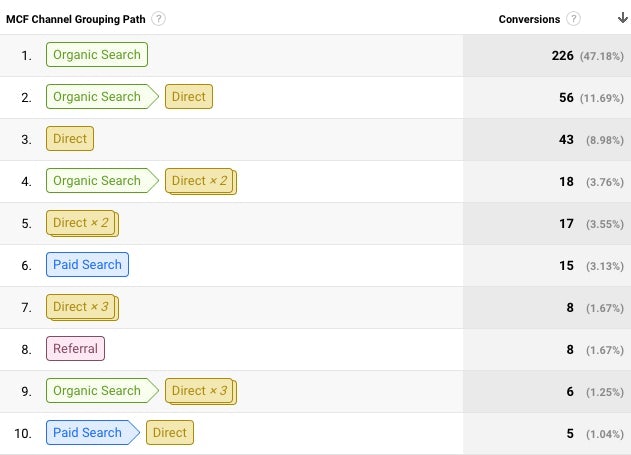
Organic search is both a strong standalone channel and a key driver to start user journeys for other channel conversions. Paid Search achieves a similar result, which could be grounds to increase the budget and scale of the campaign. Direct, on the other hand, serves only as a final path in the user’s journey, and doesn’t serve other channels well.
It’s important to note that single-step conversions are not shown by default – you’ll need to adjust the segments to see this data.
Finding a cross-channel agency partner
By now, we’ve hopefully demonstrated and convinced you that the only way forward is to embrace and deploy an integrated approach to your PPC and SEO strategies. You’ll also have a clear understanding of how you can make this happen, but often there is one fundamental factor that can make implementing an integrated strategy more challenging – working with two different agencies.
While the majority of agencies will have a positive working relationship, this may not always be the case. In this instance, it can cause a bit of a headache in terms of bringing the two channels together and ensuring you not only have full transparency on how each channel is performing, but you can work together on overcoming any challenges or unlocking new opportunities.
Beyond the ‘battle of the agencies’, choosing to have one agency partner to manage both channels can provide great efficiencies when managing your marketing budget and resources.
Moreover, integrated management allows for better coordination and optimisation of resources. A single agency handling both SEO and PPC can allocate budgets, analyse data, and adjust strategies more efficiently, as they have a holistic view of the digital marketing landscape.
This integrated approach enables agencies to identify synergies between SEO and PPC efforts, such as using PPC data to inform keyword targeting and content optimisation for SEO or leveraging SEO insights to refine PPC ad copy and targeting. By leveraging the strengths of both channels in tandem, businesses can maximise their online visibility, drive qualified traffic, and achieve their marketing objectives more effectively.
But, with so many SEO or PPC specialist agencies out there, how do you know who is best for the job?
Ultimately, we would suggest working with a cross-channel agency that has a proven capability in both SEO and PPC first and foremost, but you may also want to consider:
- Can they demonstrate internal integration and cross-channel collaboration?
- Does the business align with your business values?
- In their pitch, did they approach Search holistically, or in silos?
If you’re considering making the move, why not check out our helpful agency selection guide where you can access the opinions of like-minded individuals on how to find the right agency and hear their top tips.
Next steps
We would always recommend approach search with an integrated strategy that combines at least SEO and PPC. In an ideal world, you will also sprinkle in some digital experience and experimentation to really get the most out of our channels.
Ensuring your SEO strategy aligns with your PPC strategy is a fundamental way to build a solid foundation for marketing success, so if you feel you’re not quite there yet, why not get in touch, or take a look at some of our helpful resources that can help you to learn more about the topics covered in this article:





